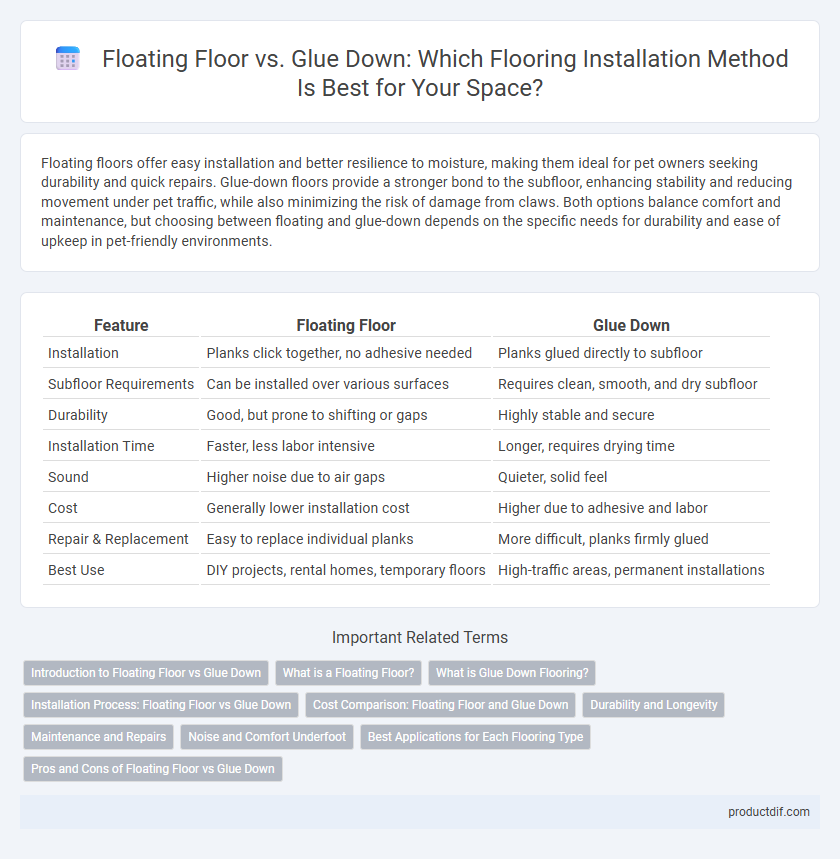Floating floors offer easy installation and better resilience to moisture, making them ideal for pet owners seeking durability and quick repairs. Glue-down floors provide a stronger bond to the subfloor, enhancing stability and reducing movement under pet traffic, while also minimizing the risk of damage from claws. Both options balance comfort and maintenance, but choosing between floating and glue-down depends on the specific needs for durability and ease of upkeep in pet-friendly environments.
Table of Comparison
| Feature | Floating Floor | Glue Down |
|---|---|---|
| Installation | Planks click together, no adhesive needed | Planks glued directly to subfloor |
| Subfloor Requirements | Can be installed over various surfaces | Requires clean, smooth, and dry subfloor |
| Durability | Good, but prone to shifting or gaps | Highly stable and secure |
| Installation Time | Faster, less labor intensive | Longer, requires drying time |
| Sound | Higher noise due to air gaps | Quieter, solid feel |
| Cost | Generally lower installation cost | Higher due to adhesive and labor |
| Repair & Replacement | Easy to replace individual planks | More difficult, planks firmly glued |
| Best Use | DIY projects, rental homes, temporary floors | High-traffic areas, permanent installations |
Introduction to Floating Floor vs Glue Down
Floating floors involve planks or tiles that interlock and rest above the subfloor without adhesive, offering easy installation and flexibility. Glue down installation secures flooring directly to the subfloor with adhesive, enhancing stability and soundproofing. Both methods suit different substrates and usage scenarios, influencing durability, moisture resistance, and maintenance requirements.
What is a Floating Floor?
A floating floor is a type of flooring installation where the planks or tiles are not attached to the subfloor but instead interlock or click together, resting on an underlayment. This method allows for natural expansion and contraction of materials, making it ideal for laminate, engineered wood, and some vinyl floors. Floating floors provide easier installation, noise reduction, and added comfort underfoot compared to glue-down options.
What is Glue Down Flooring?
Glue down flooring is a method where flooring materials, such as vinyl, engineered wood, or laminate, are directly adhered to the subfloor using specialized adhesives. This installation technique offers increased stability and sound insulation compared to floating floors, making it ideal for high-traffic or moisture-prone areas. The strong bond created by glue down flooring helps prevent movement or gaps, ensuring a long-lasting and durable surface.
Installation Process: Floating Floor vs Glue Down
Floating floor installation involves laying planks over an underlayment without adhesive, allowing for easier and faster setup with minimal subfloor preparation. Glue down installation requires spreading adhesive on the subfloor and pressing the flooring directly into it, creating a more permanent and stable bond ideal for high-traffic areas. Floating floors offer easier repairs and replacement due to the click-lock system, while glue down floors provide superior sound reduction and moisture resistance.
Cost Comparison: Floating Floor and Glue Down
Floating floor installation typically costs between $3 to $8 per square foot, offering a more budget-friendly option with easier DIY application. Glue down flooring averages $5 to $12 per square foot, reflecting higher labor and adhesive expenses but providing enhanced durability and sound insulation. Choosing between floating and glue down depends on budget constraints, long-term performance, and maintenance preferences.
Durability and Longevity
Floating floors, often engineered wood or laminate, offer moderate durability with a quick installation process and the ability to expand or contract with humidity changes, making them ideal for basements or areas prone to moisture. Glue down flooring, typically vinyl or hardwood, provides superior stability and long-term durability by firmly adhering to the subfloor, minimizing movement and reducing the risk of warping or buckling over time. The choice between floating and glue down floors significantly impacts the lifespan of your flooring, with glue down options generally delivering enhanced longevity in high-traffic or moisture-prone environments.
Maintenance and Repairs
Floating floors offer easier maintenance and repairs since individual planks can be replaced without disturbing the entire floor, reducing downtime and labor costs. Glue-down floors require more extensive effort to repair because damaged sections are firmly bonded to the subfloor, often necessitating removal of large areas or complete reinstallation. Regular cleaning and moisture control are critical for both types, but floating floors are more forgiving with minor subfloor imperfections.
Noise and Comfort Underfoot
Floating floors, installed over a padded underlayment, provide superior noise reduction and enhanced comfort underfoot by absorbing impact and minimizing sound transmission. Glue-down flooring offers a firmer, more solid feel but tends to transmit sound more directly through the subfloor, resulting in higher noise levels. Selecting a floating floor can improve acoustic insulation and provide a cushioned walking surface ideal for residential and multi-story buildings.
Best Applications for Each Flooring Type
Floating floors excel in residential settings and areas with subfloor irregularities, offering easy installation and sound insulation, making them ideal for living rooms and bedrooms. Glue-down flooring provides superior stability and moisture resistance, recommended for high-traffic commercial spaces and basements where durability and long-term adhesion are critical. Both options suit different needs based on subfloor condition, moisture levels, and usage intensity.
Pros and Cons of Floating Floor vs Glue Down
Floating floors offer easy installation and allow for natural expansion, making them ideal for DIY projects and uneven subfloors, but they may produce more noise and lack the solid feel of glue-down floors. Glue-down floors provide superior stability, enhanced sound insulation, and a longer lifespan, yet they require professional installation and can be more challenging to replace or repair. Choosing between floating and glue-down flooring depends on factors like subfloor condition, budget, and long-term durability preferences.
Floating Floor vs Glue Down Infographic

 productdif.com
productdif.com